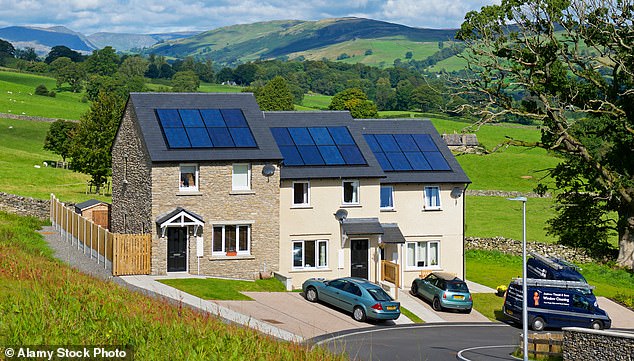The past few months have triggered a new determination for many people, whether that’s growing vegetables, learning a language or perfecting sourdough.
Now, it seems that many of us are keen to change the way we live and are looking forward to a cleaner, greener lifestyle.
One way to do this is by saving hundreds of pounds each year on your energy bills by making your home more environmentally friendly.
Any improvements will also add value to your home, as eco homes are growing in popularity.
Eco appeal: New cottages with solar roof panels in Kendal, Cumbria. More people are looking forward to a cleaner, greener lifestyle and there are Government grants to help
And this is the time to do it. The Government has launched a Green Home Grants scheme, which provides homeowners with up to £10,000 in vouchers to pay for the cost of energy-saving measures including insulation, double and triple glazing, and low-carbon heating.
‘Improving the efficiency and sustainability of your home is an investment that will become more valuable over time,’ says Kunle Barker, co-presenter of Love Your Home & Garden and Grand Designs Live, and property expert for sustainable building firm InFrame.
Here are Barker’s top tips for making green home improvements…
Plug the gaps
The place to start is insulation, which is covered under the Green Homes Grant scheme available from the end of this month.
You can claim up to £5,000 (or more if you are a low earner) towards two-thirds of the cost of the work, which must be completed before March 31, 2021.
‘Around 70 per cent of your heat goes out of the walls and if your windows are leaking, it is like throwing fivers into the wind,’ says Barker.
Draught excluders are a quick win that can be fitted around doors and windows from between £200 and £300, saving you up to £20 a year on your energy bills.
Loft insulation costs about £300, reaping an annual saving of £180 a year.
Replacing draughty windows with double glazing will keep you snug and save up to £175 a year. Prices for one window range from £350 to £600.
Barker recommends choosing windows with a so-called solar film for greater energy savings, but says triple glazing is not worth it.
InFrame uses ‘superfoil’, a Nasa space technology, in its renovations. Superfoil is a type of external solid wall insulation. It makes your home airtight and radiates heat back into the house.
‘Think of it as like wrapping your house in a huge thin duvet,’ he says. It costs £3,500 for a three-bedroom terrace and can save you about £145 a year on bills.
Boost your rating
‘There is no one-size-fits-all approach when it comes to improving the efficiency of a home, so carry out an energy survey first,’ says Barker.
An Energy Performance Certificate (EPC) rates the efficiency of your home, with G being the worst and A being the best. If you don’t have an EPC, instruct a professional to survey your property using epcregister.com. Prices vary, costing up to £120.
A higher rating can improve the value of your home. For example, going from a G to an A could add 14 per cent to the average property value in England, according to research for Moneysupermarket.com.
Low-carbon heating
IR source heat pumps and solar panels are covered by the Government’s grant.
An air source heat pump, which costs about £8,000, takes heat from the air outside and increases it to a higher temperature. If you are replacing a liquid gas heating system, you can save about £285 on your bills a year.
Solar panels are less expensive to install but not suitable for every house. You can generate your own reusable energy and earn money by transferring unneeded power to the National Grid.
Eight panels on a semi-detached house cost about £3,800 and will save typically £90 a year while earning you up to £120 a year for sending money to the grid.
Smart tech
Smart thermostats, available via the Green Homes Grant, allow you to control your heating remotely using your phone.
Some systems detect if a window has been left open and turn the heating off, others begin heating your house as you return from work.
You can also have electronic valves on radiators to adjust the temperatures of individual rooms. Prices range from £150 to around £300.
